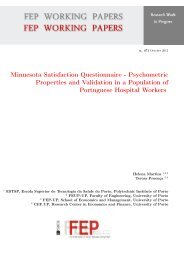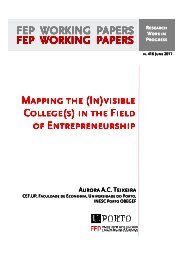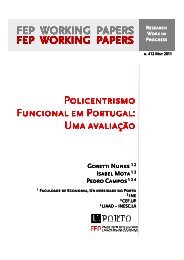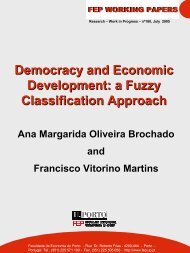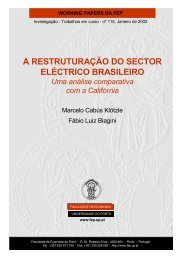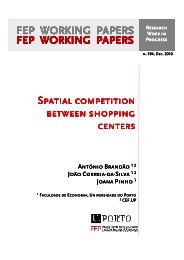Ant Colony Optimization: a literature survey - FEP - Working Papers
Ant Colony Optimization: a literature survey - FEP - Working Papers
Ant Colony Optimization: a literature survey - FEP - Working Papers
You also want an ePaper? Increase the reach of your titles
YUMPU automatically turns print PDFs into web optimized ePapers that Google loves.
where δ(S k , a) = 1 if arc a belong to the solution tree S k , and 0 otherwise.Following the work of Bin et al (2009), Yang et al (2007) use an ant-weight pheromone updatingstrategy based on the ant-density algorithm, in the Improved ACO used to solve the VehicleRouting Problem. The idea behind it is to incorporate both local and global information aboutsolutions. Therefore, every ant, representing a single route, deposits pheromone in its solutioncomponents, following∆τ k ij =QK × L × Dk − d ijm k × D k , (34)where Q is the usual proportionality constant parameter, L is the sum of the lengths of all toursin the solution, K is the total number of routes in the solution, D k is the length of tour k, d ij isthe distance between customer i and customer j, and m k is the number of customers visited inroute k. Note that, a solution is only entirely defined when all routes constructed are assembled.QThe first component , the global pheromone increment, depends on the total length of theK × Lsolution and on the number of tours, and it represents a compromise between the total cost andthe number of vehicles used. The second component Dk − d ij, the local pheromone increment,m k × Dk uses the contribution of arc (i, j) to the kth tour, which increases as d ij decreases.3.1.5 Transition Rule and Probability FunctionThis may be considered the characteristic that has less suffered from the evolution of ant algorithms.Its initial structure, as given in equation (1), is almost always used in the works of theresearchers in the area. Nonetheless, different methods have been introduced mainly associatedto the high complexity of the problem to be solved.The probability distribution used by Bouhafs et al (2006) to calculate the probability of visitingcustomer j when in customer i, in a Capacitated Location-Routing problem, also incorporatesthe savings value γ ij , for visiting customer j from customer i:P kij (t) =[τ ij (t)] α · [η ij ] β · [γ ij ] λ∑j∈J k i[τ ij (t)] α · [η β ij ] · [γ ij] λ (35)where Jik is the set of costumers not yet visited by ant k in its solution and that, by beingchosen, do not violate any constraint. The savings value is computed once at the beginning ofthe algorithm as followsγ ij = d i0 + d i0 − g · d ij + f · |d i0 − d 0j |, (36)where g and f are parameters, d ij is the distance between nodes i and j, and 0 is the startingnode.Afshar (2005) proposes a new transition rule for ant colony optimization algorithms, that is18



